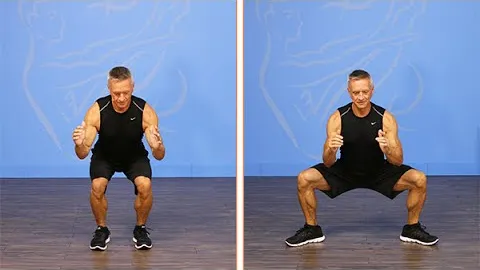
If you are looking to enhance your lower body strength and stability, the Parallel Squat to Sumo Squat exercise is an excellent choice. This dynamic movement targets multiple muscle groups, providing a comprehensive workout for your quadriceps, glutes, hamstrings, and inner thighs. In this article, we will explore the correct form, variations, the benefits associated with this exercise, and how you can incorporate it into your fitness routine.

The Parallel Squat is a foundational exercise that effectively engages your quadriceps muscles. To begin, stand with your feet shoulder-width apart, ensuring that your toes are pointing forward. Maintaining a straight back and keeping your core engaged, slowly lower your body by bending at the hips and knees. Descend until your thighs are parallel to the ground, or as low as your flexibility allows. It is crucial to maintain proper form throughout the movement and to avoid excessive forward-leaning or rounding of the lower back.
Once you have mastered the Parallel Squat, you can progress to the Sumo Squat variation, which engages additional muscle groups, including the inner thighs and glutes. To perform the Sumo Squat, begin by standing with your feet wider than shoulder-width apart, with your toes pointing outward at a comfortable angle. With your core engaged, initiate the squat by bending at the hips and knees, lowering your body until your thighs are parallel to the ground or as low as your flexibility permits. Make sure to maintain proper form by keeping your back straight, knees tracking over your toes, and heels flat on the ground.
Full Lower Body Activation: The Parallel Squat to Sumo Squat exercise activates a wide range of muscles in your lower body, including the quadriceps, hamstrings, glutes, and inner thighs. This comprehensive activation promotes balanced strength development, stability, and improved functional movement.
Increased Muscle Mass: By engaging multiple muscle groups simultaneously, this exercise stimulates muscle growth and development. This can be particularly beneficial for individuals looking to build strength, enhance athleticism, or improve overall body composition.
Functional Movement Performance: The Parallel Squat to Sumo Squat exercise closely mimics real-life movements, such as lifting heavy objects or performing daily activities that require lower body strength and stability. Incorporating this exercise into your fitness routine can improve your performance in these activities, reduce the risk of injury, and enhance overall functionality.
Improved Balance and Stability: Executing the Parallel Squat to Sumo Squat exercise requires significant core stabilization and balance. As you progress and add resistance, such as dumbbells or a barbell, your body adapts to the increased demand, leading to improved balance and stability.
Calorie Burn and Fat Loss: Squats, in general, are known for their ability to burn a high number of calories due to the large muscle groups involved. By incorporating the Parallel Squat to Sumo Squat exercise into your fitness routine, you can promote fat loss and achieve your weight loss goals more effectively.
To begin reaping the benefits of this exercise, consider incorporating the Parallel Squat to Sumo Squat into your lower body or full-body workout routine. Here are some guidelines to follow:
Warm-up: Prior to starting any exercise, it is crucial to warm up your muscles to reduce the risk of injury and improve performance. Perform dynamic stretches and low-intensity exercises that target your lower body, such as lunges or leg swings.
Starting Position: Stand with your feet shoulder-width apart for the Parallel Squat or wider than shoulder-width apart for the Sumo Squat variation. Ensure that your toes are pointing forward (Parallel Squat) or outward (Sumo Squat).
Repetitions and Sets: Aim to perform 8-12 repetitions of the exercise, gradually increasing the intensity or resistance as your strength improves. Start with 2-3 sets and gradually progress to 3-4 sets for optimal results.
Rest and Recovery: Allow yourself sufficient rest between sets to recover and maintain proper form throughout the exercise. This will help prevent fatigue-related injuries and promote muscle recovery.
Form and Safety: Maintain proper form throughout the exercise by keeping your back straight, knees tracking over your toes, and core engaged. If you experience any pain or discomfort, consult with a fitness professional to ensure correct form and technique.
The Parallel Squat to Sumo Squat exercise is a powerful addition to any fitness routine, targeting multiple muscle groups for enhanced lower body strength and stability. By performing this exercise correctly and progressively increasing the intensity, you can experience increased muscle mass, improved functionality, and enhanced balance and stability. Remember to prioritize safety and consult with a fitness professional if needed. So, seize the opportunity, and integrate the Parallel Squat to Sumo Squat exercise to take your lower body training to new heights.
If you're looking for a gym, fitness club or yoga studio, you've come to the right place.
You can find information about gyms in your area. Browse catalog of gyms and find gyms with classes which are you looking for.
On gym page you can find simple information like address, phone or website. You can find list of available classes. You can check availability of personal training or small group classes. On place page you can also see information about open hours.
You can find gyms near you with amenities, courts, studios and equipments.
Use our map to find gym at your city or district.
In Gym Navigator you can find list of exercises with movies for many body parts.
You can browse exercises catalog and find exercises the best of you.
You can also find exercises grouped into workout plans, which you can use to improve you body. Each routine show you exercises one by one and give you possibility to count you progress and count down rest time.